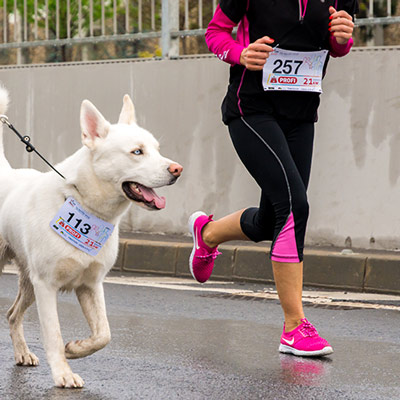Last Updated on September 7, 2023 by Dr. Alisha Barnes

Regular jogs (running) can be a great way to keep you and your four-legged friend fit. However, you want to make sure you introduce this new exercise in the right way to keep them safe and injury-free.
If you want to make your dog your new running buddy, simply follow these steps:
Make sure they are suitable for running
Certain breeds are better running partners than others. For instance, brachycephalic dogs (pugs, bulldogs, boston terriers) will never be able to join you on your morning run as they often struggle to breathe due to their shorter muzzles. Large breeds (great danes, bernese mountain dogs, and mastiffs) are also not good candidates as their large mass can predispose them to injury. The best running mate is an athletic, younger pup in good health and at a healthy weight.
Start small and work your way up
Even if your pup seems like they could handle a longer run, it is so important that you start small. Wear and tear on the joints from a consistent jog is different from that which results from play. It is best to start off in 10-minute increments. If your dog is able to handle 3 sessions without issue, you can bump up another 10 minutes. Make sure you also incorporate rest days to allow their bodies to adapt and recover.
Look for dirt trails to ease the initial impact on the joints
When you’re just getting into a running routine, it is best to start on dirt or grass to help minimize the impact on the joints. As your pup gets stronger, they will be able to tolerate running on concrete, however, the softer surfaces will always be the safest and easiest on the body.
Always include a warm-up and cool down
Like any athlete, a proper warm-up and cool-down are crucial to success. Take a few minutes to ease your pup into activity by letting them play or chase a ball. Afterward, allow them to slowly decrease their activity before loading them up into the car or putting them into a crate. This will help to prevent stiffness that occurs from cooling the body too quickly. You can also add some gentle massage and stretching to further support them.
Go at the optimal time
Hot weather and hot pavement are major no no’s for your dog. Running during the heat of the day can have a severe and sometimes deadly impact on your pup. From dehydration to burned paws to heatstroke, the ramifications are significant. It is best to run in the early mornings or late evenings when temperatures have cooled and conditions are safe.
Get them regular bodywork to improve motion and reduce injury risk
Regular bodywork, including chiropractic, physical therapy, and massage, is a great way to keep your athlete in tip-top shape. By improving range of motion, reducing muscle tension and improving overall alignment, these modalities can
